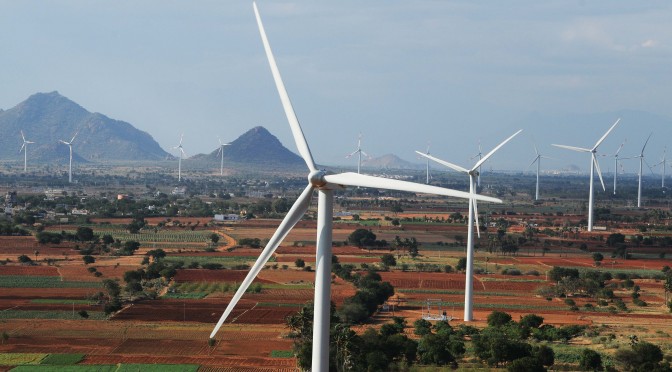Indian wind power industry is ending the year on a high note, but also with a problem it would not be unhappy with – meeting the stiff targets set by the government.
India has taken nearly a quarter century to create wind power capacity of 22,200 MW. But now, Power Minister Piyush Goyal wants the industry to ramp up installations, so that the capacity additions in 2018-19 are 10,000 MW. The most the industry added in any year was 3,168 MW in 2011-12.
“The government has given us everything we wanted, and more,” notes an industry insider, pointing to the grant of the industry’s long-standing request for restoring the tax-saving ‘accelerated depreciation’ duty, and the exemption from the 4 per cent special additional duty on imported components for wind turbines. On the works is a proposal to impose a ‘renewable generation obligation’ that will force companies putting up coal or lignite based thermal power plants to create an additional 10 per cent of their project capacities as renewable energy plants. This is expected to give that ‘extra push’, as cash-rich public sector companies such as NTPC, NLC and DVC will quickly come up with largish wind (or solar) projects.
Having given the industry all it wanted, the government is now saying, “go, do it”. That is exactly what daunts the industry. In 2014-15, India will see wind power capacity additions between 2,000 MW and 2,500 MW, roughly the same as last year. But to ramp it up 4-5 times in four years is not easy.
The challenges are well-recognised, though each player in the industry ranks them differently. Here is generally how the industry views various problems:
Land and access to construction site: A big issue with all sorts of local satraps flexing their muscle, but not a deal-breaker problem. Land middlemen have evolved as part of the ecosystem and all it takes is to pay your way through. However, it would help if the government would earmark areas for wind development.
Transmission infrastructure: Indeed, a big worry could be a deal-breaker. But the hope is that the government would keep its promise of strengthening transmission lines with projects such as the ‘green corridor’.
Finance: A major issue because even equity funds are drying up. In the last couple of years, very few wind ‘independent power producers’ have come up – some believe that only two have come up – Ostro Energy and Energon, backed by Actis and the Singapore-based Equis Funds Group, respectively. Sources say that wind power producers such as ReNew Power, Green Infra, Mytrah and Bharat Light & Power may be scrapping the bottom of the committed call-able equity funds and getting more may require some convincing.
The industry is seeking interest subvention and project-specific working capital (as opposed to company-specific limits). It wants banks not club ‘renewable energy’ industry with ‘power’ so that this industry is not affected by the NPA stigma and so that the banks do not tell it, “sorry, we can’t lend you because we have reached the limit of our exposure to the power sector.”
Components and logistics: The Indian Wind Turbine Manufacturers’ Association worries that beyond a capacity of 5,000 MW, the industry will face shortage of critical components particularly, bearings and yaw motors. It fears that the suppliers will not ramp up their capacities in tandem and would prefer to wait and see if the promised demand is indeed there, before putting down money in capacity expansions. However, others in the industry, notably, Gamesa and Suzlon, do not believe that components shortage will be a major problem.
Then there is logistics – mainly, trailers to carry the ever-getting-longer blades – will be another issue. Even if enough trailers are available, shortages will be seen in patches of time, when order executions gather pace.
Most believe that up to a capacity of 5,000 MW, these issues may not pose a threat, but beyond that things get really shaky. But still 5,000 MW is a respectable number and to that extent, the industry is smiling at the end of 2014.



